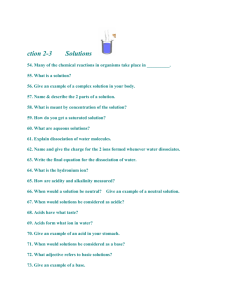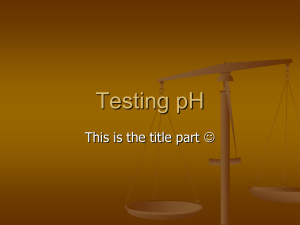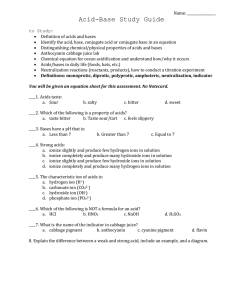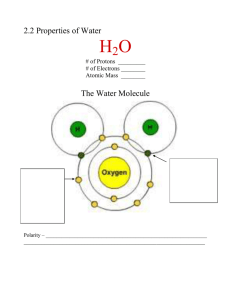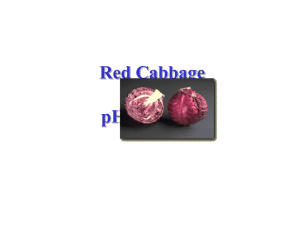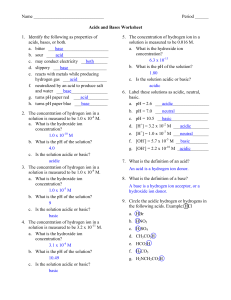che142lab07.doc
advertisement
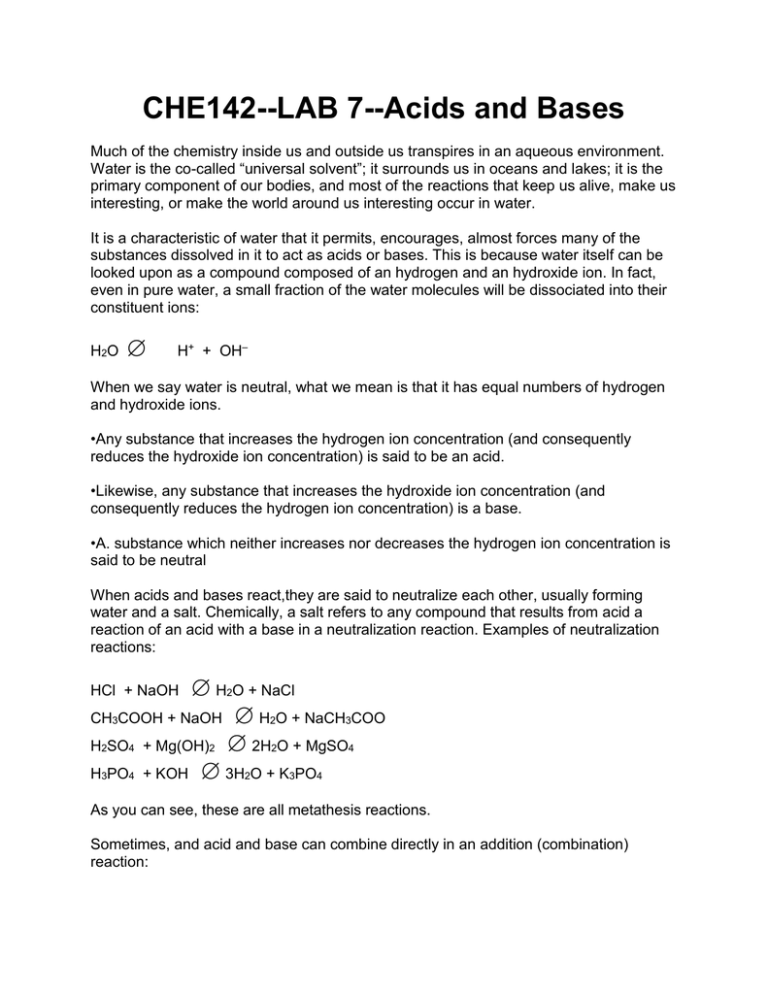
CHE142--LAB 7--Acids and Bases Much of the chemistry inside us and outside us transpires in an aqueous environment. Water is the co-called “universal solvent”; it surrounds us in oceans and lakes; it is the primary component of our bodies, and most of the reactions that keep us alive, make us interesting, or make the world around us interesting occur in water. It is a characteristic of water that it permits, encourages, almost forces many of the substances dissolved in it to act as acids or bases. This is because water itself can be looked upon as a compound composed of an hydrogen and an hydroxide ion. In fact, even in pure water, a small fraction of the water molecules will be dissociated into their constituent ions: H2O H+ + OH– When we say water is neutral, what we mean is that it has equal numbers of hydrogen and hydroxide ions. •Any substance that increases the hydrogen ion concentration (and consequently reduces the hydroxide ion concentration) is said to be an acid. •Likewise, any substance that increases the hydroxide ion concentration (and consequently reduces the hydrogen ion concentration) is a base. •A. substance which neither increases nor decreases the hydrogen ion concentration is said to be neutral When acids and bases react,they are said to neutralize each other, usually forming water and a salt. Chemically, a salt refers to any compound that results from acid a reaction of an acid with a base in a neutralization reaction. Examples of neutralization reactions: H2O + NaCl CH3COOH + NaOH H2O + NaCH3COO H2SO4 + Mg(OH)2 2H2O + MgSO4 H3PO4 + KOH 3H2O + K3PO4 HCl + NaOH As you can see, these are all metathesis reactions. Sometimes, and acid and base can combine directly in an addition (combination) reaction: NH3 + HCl NH4Cl. The acidity or basicity of a substance when it is dissolved in water is characterized by a concept referred to as the pH scale. The pH scale gives us an idea of the acidity or basicity of a solution. Most pH readings lie between the numbers 1 and 14. Just as in golf, where one wins with the lowest score, the more acidic a substance, the lower its pH. Any pH below 7 is considered to be acidic. Any pH above 7 is considered to be basic. A ph of 7 represents a neutral solution. We can measure pH in two basic ways: we can use an indicator (a dye that is sensitive to pH) or we can use an electronic instrument known as a pH meter. Some dyes give us an “on-off” value, that is there is only a single color change. Litmus paper and methyl orange are examples of this. Other dyes, or mixtures of dyes, can be utilized to give a more descriptive range of pH values. So-called universal pH paper uses a mixture of dyes to give a series of colors corresponding to different pH’s. Of particular interest are dyes that are members of the anthocyanidin family of molecules, which are discussed in detail in your book in Chapter 5. Cyanidin, an anthocyanidin with 2 hydroxyl groups on the distinct benzene ring, undergoes a wide variety of color changes over the pH range commonly encountered in the laboratory or the kitchen. The anthocyanidins in wine are also pH sensitive, and are responsible for the change in flavor and color as wine ages. In today’s lab you will examine the pH of a variety of common chemicals, most of them used in the house using a pH meter, and then re-examine them using a variety of pH sensitive dyes, either in the form of pH paper or in the form of a dye solution. You will extract your own acid base indicator from red cabbage, and use this to examine your substances, and, finally, you will INSTRUCTIONS Work in groups of 2 or 3. Use 100 ml beakers. Fill them halfway with your test solutions of the following substances: Ammonia Baking Powder Detergent (powder) Detergent (liquid) Tap Water Distilled Water Seltzer water 7-up vinegar Sani flush Hydrochloric acid Aspirin Milk of Magnesia If the substance is solid, make a dilute solution of it by mixing a half a teaspoon in a beaker filled halfway with water. Transport your beakers to the computer lab and measure your pH as your instructor demonstrated for each or your solutions. Bring your solutions back to the general chem lab and then, in a spot plate, examine their effect on: •Small pieces of litmus paper •Small pieces of universal pH paper • A drop or two of phenolpthalein • A drop or two of methyl orange After you have finished the spot plate experiment, extract the indicator from red cabbage using a blender and strainer. Divide your remaining solutions in half. Treat one half of each of the solutions with the cabbage juice, and the other half with the red wine supplied by your instructor and note any color changes. Use the TUMS tablet provided by your instructor and add 0.1M HCl with a plastic dropper until it is neutralized. Before you start this reaction, think hard about the best way to decide if neutralization is taking place. REPORT Here are some ideas which might help you fashion a good report--you are not limited to these, but you might find them helpful as starting points. In your report, tell which of your compounds are acidic, which are basic and which are neutral. Which are more acidic and which are less acidic? Why, chemically speaking, are some basic and why are some neutral? Explain, using your book and lab notes as a guide how red cabbage and wine are indicators for pH. Based on your pH measurements, describe how you might use each of the color indicators to obtain information about the acidity of a solution. Be specific when describing how specific color changes correspond to particular ranges of pH.
